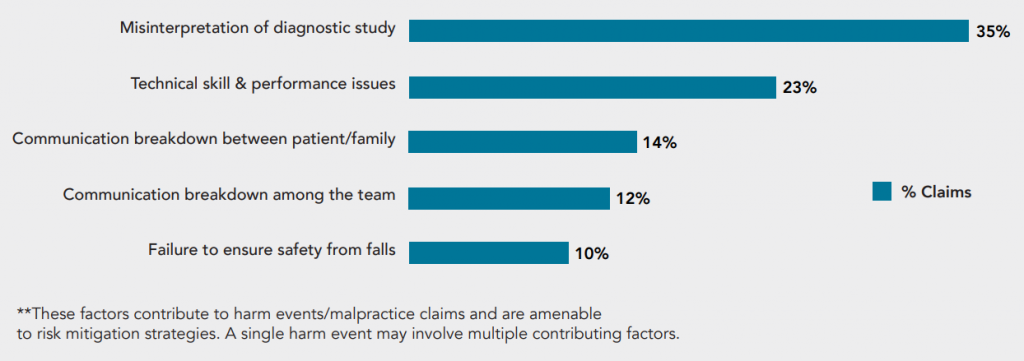What We Learn From Radiology Malpractice Claims
Failure to diagnose cancer
A 60-year-old woman who was previously diagnosed with breast cancer was referred to a radiologist for radiation treatment planning post-chemotherapy. A chest CT identified an incidental lesion in her lung, but the radiologist made no follow-up recommendations. His CT report contained two incomplete sentences about the lung lesion, which made the report ambiguous and confusing. Over the next several months, the woman received 33 radiation treatments for her breast cancer. Neither the radiologist nor the oncologist communicated the incidental lung finding to the woman and there was no follow-up imaging ordered.

Two years later, the woman was complaining of a worsening cough. Her physician ordered a chest X-ray that showed an abnormality, and a follow-up CT indicated a mass in the upper right lobe of her lung. He referred her to a specialist who performed a biopsy that showed non-small cell lung cancer: stage IV. One day later, an MRI of her brain showed multiple intracranial lesions consistent with metastases.
The woman was referred to a thoracic surgeon who shared that had the lung lesion been recognized two years earlier, treatment likely would have consisted of a surgical resection of a segment of the lung and would have likely been curative. Her prognosis was poor. The woman underwent brain radiation treatments to reduce related symptoms.
The woman filed a malpractice claim against the radiologist and her oncologist alleging failure to diagnose lung cancer in a timely manner. The experts who reviewed the care were critical of the radiologist for failing to provide clear diagnostic information about the incidental lung lesion on the CT and recommend follow-up imaging. They were also critical of the oncologist for failing to clarify the confusing report and failing to follow up on the incidental finding. The experts opined that the delay resulted in a lost chance of survival. The malpractice case was closed with a payment to the woman on behalf of the radiologist.
Top allegations in radiology claims
In our analysis of Constellation malpractice claims, radiology tied for the seventh most expensive, and eighth most frequently cited clinical service responsible for care at the time of an alleged harm event. As this diagnostic error case illustrates, in 32% of radiology claims there was a high severity patient injury that resulted from care.

The top allegations in radiology claims are:
- Diagnostic errors
- Medical treatment issues
- Failure to ensure safety from falls during treatment
- Improper patient monitoring
The top missed diagnoses in these claims were:
- Cancers: 34%
- Fractures and dislocations: 21%
- Infections: 9%
- Vascular issues: 9%
Top contributing factors
Contributing factors are risk management issues that contribute to a harm event (or malpractice claim) and are amenable to risk mitigation strategies. Most cases involve multiple contributing factors. The top contributing factors in radiology claims are misinterpretation of a diagnostic study, technical skill and performance issues, communication breakdowns with the patient and among the team, and failure to prevent a fall-related injury.

Risk mitigation strategies for radiologists
- Provide clinical decision support tools (e.g., clinical algorithms, artificial intelligence) to help clinicians develop robust differential diagnosis lists and rule out potentially serious conditions.
- Mitigate factors that impact interpretation and perception errors, such as diminishing interruptions, having previous images available, implementing overreads/random reads, or viewing images before clinical details are known.
- Encourage joint strategy discussions between the ordering clinician and the radiologist (e.g., pre-imaging decision-making and post-imaging diagnosis) to improve the diagnostic process.
Risk reports
Our risk reports analyze Constellation’s malpractice claim data on a wide range of topics and specialties, and share insights clinicians, care teams, clinics, hospitals and senior living organizations can use to help reduce harm events and malpractice claims.
Are you a client of Constellation? Sign in to MyAccount to access exclusive customer versions of our risk reports. The expanded reports share actionable insights and strategies that you can utilize to help reduce harm events and malpractice claims. After you sign in, follow Risk Resources > Tools & Resources > Publications > Risk Reports. You also have access to a host of Bundled Solutions (in Risk Resources) that cover topics such as Preventing Diagnostic Error, Obstetrics and Surgery/Anesthesia to assist you in your risk mitigation efforts.
Constellation® is a trademark of Constellation, Inc.
Latest Blog Articles
Five Steps to Reduce Generative AI Risks in Healthcare
AI is already assisting physicians and healthcare organizations in many ways. Learn how its use may impact liability and what strategies can mitigate risk.
Five Steps to Reduce Obstetrical Errors and Malpractice Claims
Learn how to reduce obstetrical harm using evidence-based protocols for managing high-risk situations, joint team fetal monitoring education, and enhanced teamwork.
How to Reduce Surgical Harm and Malpractice Claims
In an analysis of our medical professional liability claims, surgical allegations are #1 in occurrence and #2 in cost. Learn how to reduce surgical malpractice risk.
